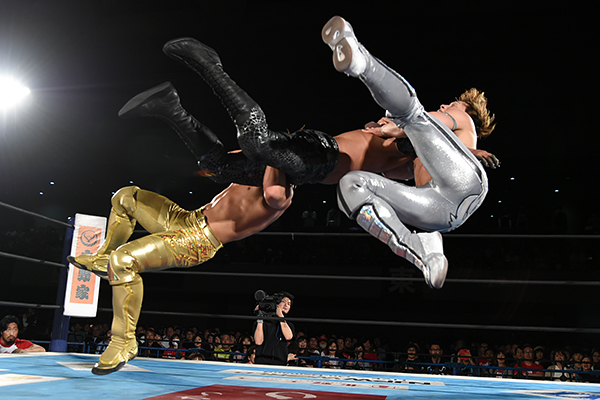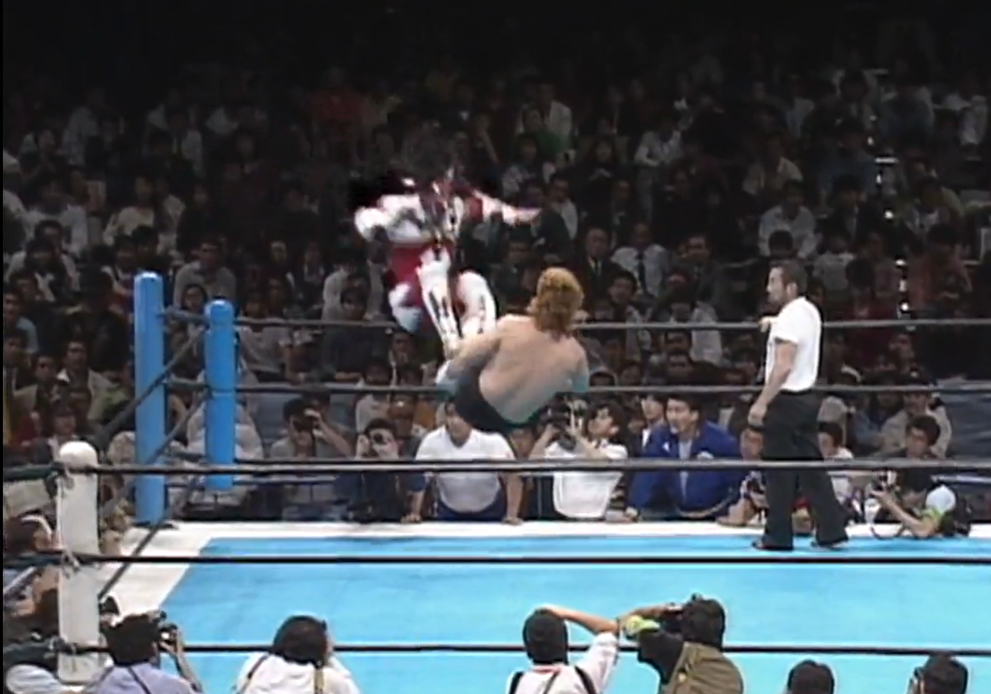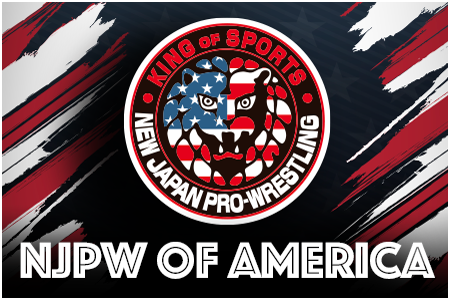The end of April and the start of May usually coincides with a stretch of national holidays in Japan that get the affectionate moniker of Golden Week. This year, ‘GW’ stands for ‘Gaman (self discipline) Week’ as we can’t go out and enjoy life professional wrestling, but there’s plenty of moments from the past on NJPW World to enjoy while staying home.
April 26, 2019: Gold stays in Roppongi

Returning from excursion at King of Pro-Wrestling in 2017, SHO and YOH instantly made a tag team mark. Defeating Ryusuke Taguchi and Ricochet in Ryogoku, Roppongi 3K won the IWGP Junior Heavyweight Tag Team Championships in their debut, and went on to win the Super Junior Tag Tournament, a feat they repeated in 2018 and 2019. More tag gold followed, but the team would learn that winning title belts and keeping them are two entirely different matters.
Roppongi 3K would fall at the first defense hurdle in their initial reigns, leading to a lot of criticism being directed at the ‘gold and silver standard’. Their record ate at SHO and YOH, who sought not only to get a first defence under their belts, but to do so against the toughest competition possible.
BUSHI and Shingo Takagi represented that competition on the Road to Dontaku in 2019. Back in March, a pinfall victory over BUSHI saw Roppongi 3K to their third junior tag reign, but it was more than a matter of pushing Roppongi advantage over the Los Ingobernables De Japon team. Ever since Shingo Takagi came into NJPW the prior October, he threatened SHO’s status as the most feared power based junior heavyweight in the game; SHO’s obsession with the as yet undefeated Dragon was explosive as it was dangerous.
April 27 2008: Greatly Bashed Hiroyoshi

Hiroyoshi Tenzan was never a stranger to rule breaking controversy. He was, more often than not, an instigator through the 1990s and 2000s as part of groups like nWo Japan and Team 2000. His experience in those units made him the perfect fit to lead Great Bash Heel in the early part of their disruptive life, but when Tenzan suffered an injury, he would be the victim of a coup d’etat in the early part of 2008, expelled from a group he helped create, while Togi Makabe rose to the fore.
Tenzan would form an unlikely alliance with Takashi Iizuka though, and the two gelled well to bring the fight specifically to the Most Violent Players team of Makabe and Toru Yano. A win for Iizuka and Tenzan over the then IWGP Tag Team Champions in Korakuen Hall, and a blossoming companionship took them to Osaka, and a match with the titles at stake.
Tyhere was no questioning Tenzan’s loyalty to his partner, as he sacrificed his own body to save Iizuka from a Makabe chairshot. Yet when a bloodied Tenzan reached out to take Iizuka late in the match, he received no response, and later, a devastating choke hold.
In the coming days, Iizuka would entomb the spirit of his former self in a Tokyo shrine, and underwent a radical transformation from loyal fighter to deranged madman.
April 29, 1996: A Spiritual Experience

On April 29 1996, Golden Week saw a hotly anticipated Tokyo Dome card. Shinya Hashimoto would attempt to wrest control of the IWGP Heavyweight Championship from UWFi’s Nobuhiko Takada in the main event, and WAR’s Genichiro Tenryu would do brutal battle with NJPW’s Tatsumi Fujinami, but it was Great Muta and the young Jinsei Shinzaki that captured the imaginations of thousands perhaps most of all.
Jinsei Shinzaki had emerged earlier in the decade in the locally oriented Michinoku Pro organization, where he drew interest with a heavyweight size, but a wrestling style that evoked the lucha libre and strong style hybrid that founder Great Sasuke popularized. Very early in his career, Shinzaki would be invited on excursion to America and the WWF, deciding he would only return to Japan if his dream match with the Great Muta could be made.
That match was indeed made on this spring 1996 night. Shinzaki had wrestled under the name Hakushi in the US, and reprised that name in the Tokyo Dome, the stoic young man adorned with the kanji representing a Buddhist sutra. He stood in stark visual contrast to the enigmatic and somewhat demonic Muta, who had his own career transformed in the United States on excursion in the 1980s. Shinzaki had a tremendous opportunity to make a name for himself on his return to Japan, but Muta had violent intentions on his mind.
April 30, 1992: The Top of the Super Juniors

In recent years, this period has become the season of junior heavyweights; all that started in April 1991, when Top of the Super Juniors returned, a league based tournament that resurfaced after an original 1988 outing.
Seven wrestlers participated in a single block league, and while a diminutive field compared to the modern Best of the Super Juniors’ 20 strong, it was an impressive one. Owen Hart, Negro Casas, Pegasus Kid, Dave Finlay and Flying (later Too Cold) Scorpio made a strong batch of non Japanese contenders, with Norio Honaga and Jyushin Thunder Liger being domestic participants.
Liger and Honaga would make the finals of a tournament that not only would decide who was at the top of the division for the duration of the tour, but going forward. After setting the wrestling world on fire following his debut two years earlier, Liger sought to bring further attention to the junior heavyweight division, and when the Top of the Super Juniors was announced as coming back after a three year hiatus, Liger willingly vacated his IWGP Junior Heavyweight Championship to be contested in the tournament.
It all came down to Liger and Norio Honaga. 12 year veteran Honaga was by no means a fan favourite. Aligning himself with the likes of Hiro Saito and Super Strong Machine, he was a prominent member of the despised Blond Outlaws faction, and was embroiled in a rivalry with Liger almost as soon as the masked man debuted. Here though, he was intent on out-wrestling the future legend on his own, and climbing to the top of his division.
As questionable as Honaga’s attitude may have been, he was every bit the match of Liger in the ring, as we found out in this hotly contested final.
May 1, 1986: Brutal Pride

1984 saw a seachange in NJPW, sparked by the sudden departure of roster members both established and up-and-coming, to form an upstart promotion called UWF.
The original Tiger Mask was joined by Yoshiaki Fujiwara, and hot young prospects Akira Maeda and Nobuhuiko Takada in the new group, which saw a hard hitting style that predicted the rise of mixed martial arts in Japan over a decade later. The UWF was not long for the world however, and at New Year Dash in 1986, the group returned.
The NJPW locker room was not welcoming the ‘U-turners’ back with open arms, but the UWF contingent were steadfast in their desire to prove themselves against the best New Japan had to offer. This led to a league based tournament of UWF wrestlers during what was then the New Year Dash tour, its winner, Fujiwara facing Antonio Inoki.
When that match ended in controversy however, issues between the two camps only continued to escalate, leading to a May 1 meeting in Ryogoku Sumo Hall. The match was a five vs five elimination contested under gauntlet rules; singles matches with the winner staying on.
By the time Yoshiaki Fujiwara took on Tatsumi Fujinami, UWF were in the plus position. Having lost Nobuhiko Takada, Kazuo Yamazaki and Osamu Kido, there was still Fujiwara and Maeda on the U-side left, but Fujinami was the only NJPW member remaining, after Keiichi Yamada, Seiji Sakaguchi, Shiro Koshinaka and Kengo Kimura had all been sent packing. The deck was stacked, and the twisted Fujiwara sought to stack it further.





